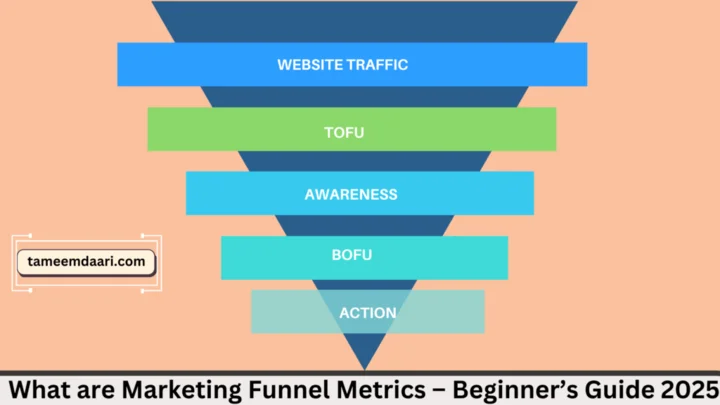In 2025, marketing success hinges on understanding marketing funnel metrics—the critical data points that reveal how prospects progress from initial curiosity to steadfast loyalty. What are Marketing Funnel Metrics – Beginner’s Guide in 2025 With evolving consumer behaviors, stricter privacy laws, and AI-driven tools, tracking the right metrics is no longer optional. Whether you’re a startup founder, small business owner, or new marketer, this guide breaks down the essential metrics for every funnel stage, tailored to the trends of 2025. Let’s dive in.
What Is a Marketing Funnel?
A marketing funnel maps the customer journey from the first encounter with your brand to becoming a repeat buyer and advocate. It’s divided into several key stages:
Stages of the Marketing Funnel
- Awareness: Prospects first learn about your brand.
- Consideration: Prospects evaluate your offerings.
- Conversion: Prospects take action and make a purchase.
- Retention: Customers return for repeat buys.
- Advocacy: Satisfied customers promote your brand to others.
Tracking metrics at each stage helps identify leaks in the funnel, optimize campaigns, and maximize your ROI.
Key Marketing Funnel Metrics for 2025
Awareness Stage Metrics
Goal: Measure how effectively you attract new audiences.
- Website Traffic: Total visitors segmented by organic, direct, and referral sources.
- Social Media Reach: Impressions, followers, and shares across platforms.
- Click-Through Rate (CTR): Percentage of users clicking on your ads or content.
- Brand Search Volume: Frequency of brand name searches (tracked via tools like Google Trends or SEMrush).
2025 Trend:
With third-party cookies disappearing, shift focus to contextual targeting (e.g., topic-based ads) and owned media (blogs, podcasts) to boost brand awareness.
Consideration Stage Metrics
Goal: Assess engagement and gauge consumer interest.
- Bounce Rate: Percentage of visitors leaving your site without interacting.
- Time on Page: Indicates the relevance and quality of your content.
- Email Open Rate: Measures the effectiveness of your subject lines and email content.
- Lead Quality Score: Rates leads based on fit using demographics and behavioral data.
2025 Trend:
Implement AI-powered chatbots to qualify leads in real time and deliver personalized content through dynamic landing pages.
Conversion Stage Metrics
Goal: Track how many prospects transform into customers.
- Conversion Rate: Percentage of visitors who complete a desired goal (purchase, sign-up, etc.).
- Average Order Value (AOV): Average revenue generated per transaction.
- Cost Per Acquisition (CPA): Ad spend divided by the number of conversions.
- Cart Abandonment Rate: Percentage of users who add items to their cart but leave without purchasing.
2025 Trend:
Leverage live shopping experiences on platforms like TikTok Shop and Instagram Live, along with one-click payment systems to minimize friction and boost conversions.
Retention Stage Metrics
Goal: Measure customer loyalty and repeat purchase behavior.
- Customer Retention Rate: Percentage of customers who return for additional purchases.
- Repeat Purchase Rate: Frequency of repeat purchases from existing customers.
- Churn Rate: Percentage of customers who stop buying from your brand.
- Net Promoter Score (NPS): Likelihood of customers recommending your brand (scored on a scale of 0-10).
2025 Trend:
Adopt subscription models and AI-driven loyalty programs that offer personalized rewards to keep customers engaged and returning.
Advocacy Stage Metrics
Goal: Gauge the impact of word-of-mouth and customer loyalty.
- Referral Rate: Percentage of customers referring others to your brand.
- Social Shares: Volume and impact of user-generated content (UGC) mentions.
- Reviews/Ratings: Overall volume and sentiment of customer reviews (e.g., 5-star ratings).
- Brand Sentiment: Monitored using social listening tools like Brandwatch to assess positive or negative mentions.
2025 Trend:
Capitalize on micro-influencers and community-driven marketing through platforms such as Discord and Reddit to amplify advocacy efforts.
Why These Metrics Matter in 2025
Embracing a Privacy-First Approach
- Privacy-First Tracking:
With Google phasing out third-party cookies and stricter GDPR regulations, marketers must rely on first-party data (e.g., email sign-ups, customer surveys) to track engagement.
Leveraging AI-Powered Analytics
- AI Tools:
Advanced tools like ChatGPT and Google Analytics 4 (GA4) enable predictive insights, identify funnel leaks, and automate optimization efforts, ensuring your strategy remains agile and effective.
Navigating Economic Pressures
- Efficient Spending:
In an era of economic uncertainty and inflation, focus on high-ROI funnel stages—such as retention—where investment can yield significant long-term benefits compared to acquisition alone.
Tools to Track Marketing Funnel Metrics
- Google Analytics 4 (GA4):
Provides cross-device tracking of user journeys. - CRM Platforms:
Tools like HubSpot and Salesforce manage leads and customer retention. - Social Media Insights:
Utilize Meta Business Suite and Hootsuite for comprehensive social media analytics. - Email Marketing Platforms:
Monitor open rates and CTR with Mailchimp or Klaviyo. - AI Tools:
Use ChatGPT for content analysis and Jasper for campaign ideation to stay ahead of trends.
Common Mistakes to Avoid
- Ignoring Retention:
Remember, acquiring a new customer costs up to 5x more than retaining an existing one. - Overlooking Mobile Metrics:
With 60% of 2025 purchases happening on mobile, ensure you’re tracking mobile conversion rates effectively. - Focusing on Vanity Metrics:
Likes and follower counts don’t drive revenue. Prioritize actionable metrics like Customer Acquisition Cost (CAC) and Lifetime Value (LTV).
How to Improve Your Funnel in 2025
Map the Customer Journey
- Identify Pain Points:
Use surveys and feedback to uncover obstacles in the customer journey.
A/B Test Everything
- Experiment:
Test different headlines, calls-to-action (CTAs), and checkout flows to see what drives the best results.
Leverage Automation
- Drip Campaigns:
Automate nurturing emails to keep leads engaged throughout the funnel.
Enhance Post-Purchase Experience
- Customer Engagement:
Request reviews and offer incentives for referrals to foster a community of loyal customers.
Conclusion
Mastering marketing funnel metrics in 2025 means balancing data-driven decisions with empathy for your audience. By tracking these core metrics, investing in AI-powered analytics, and prioritizing customer retention, you’ll be well-equipped to optimize your marketing strategy in an increasingly competitive landscape. Start today by mapping your customer journey, refining your funnel metrics, and embracing the innovative trends that will define the future of digital marketing.
